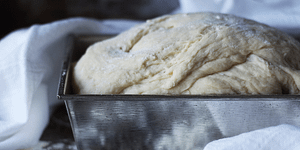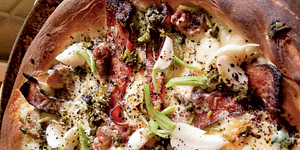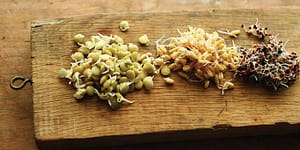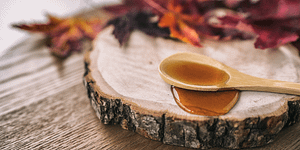Veggie Mandala with Chervil Aioli Sauce: A Natural Spring Recipe

With the birth of spring comes its profusion of gifts—the warm sun, higher temperatures, and (best of all) fertile soil. With each day, more colors seem to burst forth—both in nature and on our plates. This veggie mandala is traditionally served directly on the surface of the entire length of the farm table, but, whether you use serving platters or eat right off the table, this light dish will be a welcome shift from the heavier foods of winter.
This excerpt is from The Occidental Arts and Ecology Center Cookbook by The Occidental Arts and Ecology Center with Olivia Rathbone. It has been adapted for the web.
Photo Credit: Tali Aiona.
Veggie Mandala
An OAEC tradition for parties and celebrations is to create a giant colorful mandala out of diverse garden veggies served directly on the surface of the entire length of the table. An assortment of raw, blanched, and roasted elements adds to the diversity of the flavors.
Ingredients for 4-6 servings:
- 2 ½ pounds assorted brightly colored veggies: brassica florets, roots, and whatever other veggies are happening in the garden or at the farmers’ market
- 1 bunch large edible garden leaves: Rainbow chard, variegated collards, fig or grape leaves, the large side leaves of cauliflower or broccoli—whatever looks big and healthy
Ingredients for 30-40 servings:
- 15 pounds assorted brightly colored veggies: brassica florets, roots, and whatever other veggies are happening in the garden or at the farmers’ market
- 5 bunch large edible garden leaves: Rainbow chard, variegated collards, fig or grape leaves, the large side leaves of cauliflower or broccoli—whatever looks big and healthy
Procedure
- Wash, peel, and chop the vegetables into attractive flippable spears and keep separate. Decide which vegetables make sense to blanch, roast, or leave raw, choosing a few for each category. For example, in the summertime, leave juicy vegetables like cherry tomatoes and cucumbers raw. In the winter, roast the fennel and winter squash. Parboil or roast the remaining roots or florets, depending on your mood.
- Spread the vegetables to be roasted in a single layer on separate cookie sheets, drizzle with oil, sprinkle with salt, and bake in a 375° oven for 20 minutes, flipping as needed.
- Meanwhile, blanch each type of vegetable separately (see below for how to blanch veggies).
- To serve, clean your serving table well with soap and water.
- Cover the surface with large edible leaves, then thoroughly arrange the assortment of veggies in a beautiful pattern with a bowl of Chervil Aioli (see recipe further below) or an herb pistou for dipping. Circle around the food and meditate on the abundance!
Blanching Veggies
One of the secrets to getting people to fall in love with vegetables, especially green ones, is blanching. By locking in the vivid color, fresh texture, flavor, and nutrients, veggies are elevated to center stage rather than being relegated to a forgettable side role. When cooking for a crowd, this is also a convenient way to prepare veggies ahead of time to be reheated or incorporated into a dish later.

Photo by Talia Aiona
Get a big pot of water (the higher the water-to-vegetable ratio, the better) to an aggressive boil on the stove. Add lots of salt, about ½ cup per gallon of water—this helps prevent the color from leaching out into the cooking water and perfectly preseasons the vegetables. Meanwhile, prepare an ice bath by filling a large bowl with ice and cold water. Slice and stage the raw veggies.
Note: Be sure to blanch each vegetable separately, as cooking times will vary.
Put your first round of raw-cut veggies into the basket and lower gently into the rapidly boiling salt water. For small veggies like peas, 30 seconds should do; with larger cuts or root veggies, like julienned carrots, you may need to cook them for 4 to 6 minutes. Keep a close eye on them because a few seconds can mean the difference between vibrant al dente and mushy gray.
When the color brightens up and the texture is cooked but still retains a hint of firmness (stick a fork in or taste one), pull the colander basket out, draining out as much of the hot water as possible, and then submerge the colander in the ice bath to halt the cooking process. When the veggies have completely cooled, remove the colander and drain completely. Let the pot of water come up to boiling again before starting the next round and add more ice to the ice bath as needed.
Blanched vegetables can be frozen like this or stored in the fridge for a day.
To serve immediately as a simple side, return the vegetables to a clean pot on the stovetop and reheat on medium-high either covered with a dash of water or uncovered tossed with oil. Serve with simple olive oil and salt, a dash of tamari, or a tab of herb butter.
Chervil Aioli
Ingredients for 4-6 servings (makes a little over 1 cup):

1 very small clove garlic, less than a teaspoon crushed (optional)
1 cup oil
Salt
Squeeze of lemon
1 tablespoon finely chopped fresh chervil, or substitute a combination of tarragon and parsley
Ingredients for 30-40 servings (makes 4 cups):
4 farm-fresh egg yolks from clean, healthy chickens (don’t use factory-farmed eggs for this—or any—recipe)—room temperature
2 very small cloves garlic, 1 teaspoon crushed (optional)
4 cups oil
Salt
Squeeze of lemon
1/3 cup finely chopped fresh chervil, or substitute a combination of tarragon and parsley
Procedure
- Let your egg sit out on the counter until it comes up to room temperature.
- Separate the egg and reserve the white for another use. If you’re using garlic, crush it with a garlic press or mortar and pestle into a smooth paste and stir it into the egg yolk.
- Add about a quarter of the oil and whisk until a very well-incorporated mixture forms.
- Drizzle in the rest of the oil in a thin stream while whisking it all the while.
- Add salt and lemon to taste.
- Stir or blend in the chopped chervil. Use right away.
Recommended Reads
Recent Articles
Want to spice up your traditional bread recipes? This salt-rising bread recipe by fermentation expert Sandor Ellix Katz has all the simplicity, flavor, and uniqueness you’ve been searching for! The following is an excerpt from Sandor Katz’s Fermentation Journeys by Sandor Ellix Katz. It has been adapted for the web. What Is Salt-Rising Bread? Salt-rising…
Read MoreNothing says “spring” like a fresh, foraged meal! Savor the flavors of the season with this Milkweed Bud Pizza recipe.
Read MoreWhat’s so great about oyster mushrooms? First, you can add them to the list of foods that can be grown indoors! They are tasty, easy to grow, multiply fast, and they love a variety of substrates, making oyster mushrooms the premium choice. The following is an excerpt from Fresh Food from Small Spaces by R. J.…
Read More







